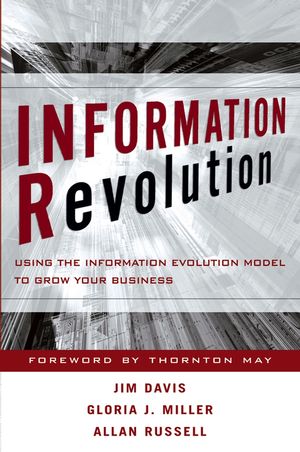Information Revolution: Using the Information Evolution Model to Grow Your BusinessISBN: 978-0-471-77072-5
Hardcover
224 pages
January 2006
 |
||||||
Preface.
Acknowledgments.
Chapter 1: Seven Realities That Jeopardize Business Survival: Why Organizations Have to Reassess Their Information Management Strategies.
Reassess Your Information Management Strategy.
The Permanently Volatile World.
Darwinism on a New-Millennium Timeline.
Chapter 2: Information Evolution Model: An Evolutionary Path to Corporate Survival.
Five Steps to Maximize the Value of Information.
Level 1: The Operational Enterprise: Focus on the Individual and Day-to-Day Tactics.
Level 2: The Consolidated Enterprise: Gaining Department-Level Perspective.
Level 3: The Integrated Enterprise: An Enterprise-Wide Perspective.
Level 4: The Optimized Enterprise: Nimble, Adaptable, and Efficient.
Level 5: The Adaptive, Innovating Enterprise: Creating Continuous and Sustainable Growth through Innovation.
Practical Applications of the Model.
Chapter 3: On the Levels: Information Evolution in the RealWorld.
A Closer Look at the Level 1 (Operate) Organization: Individualism and Day-to-Day Tactical Mode.
A Closer Look at the Level 2 (Consolidate) Organization: Consolidating Goals and Information into a Departmental View.
A Closer Look at the Level 3 (Integrate) Organization: Integrated into an Enterprise-Wide View.
A Closer Look at the Level 4 (Optimize) Organization: Optimized for Efficiency and Productivity.
A Closer Look at the Level 5 (Innovate) Organization: Driven by Continuous Innovation.
Chapter 4: Dimension Tension: When the Whole Is Less Than the Sum of the Parts.
What Happens When Dimensions Are Out of Alignment.
Different Types of “Dimension Tension”.
Chapter 5: Your Business GPS: Objectively Gauge Where Your Organization Stands.
Where Does Your Organization Stand?
Information Evolution Model Self-Assessment Quiz.
What Your Quiz Score Reveals.
What Happens If You Don’t Assess Where You Stand?
Where Should Your Organization Be on the Evolutionary Scale?
Advancing up the Levels.
Chapter 6: Getting out of Operational Mode: The Transition from Level 1 to Level 2.
Making the Transition from Level 1 to Level 2.
Potential Challenges along the Way.
Landmarks of Progress.
What the Organization Gains from Reaching Level 2.
Chapter 7: Gaining an Enterprise View: The Transition from Level 2 to Level 3.
Making the Transition from Level 2 to Level 3.
Potential Challenges along the Way.
Landmarks of Progress.
What the Organization Gains from Reaching Level 3.
Chapter 8: Gaining Market Leadership: The Transition from Level 3 to Level 4.
Making the Transition from Level 3 to Level 4.
Potential Challenges along the Way.
Landmarks of Progress.
What the Organization Gains from Reaching Level 4.
Chapter 9: Reaching Sustainable Growth: The Transition from Level 4 to Level 5.
Making the Transition from Level 4 to Level 5.
Potential Challenges along the Way.
Landmarks of Progress.
What the Organization Gains from Reaching Level 5.
Chapter 10: Information Evolution Assessment Process.
Information Evolution Assessment Process.
Why Go through This Formal Assessment Process?
Interview Questions for the Infrastructure Dimension.
Interview Questions for the Knowledge Process Dimension.
Interview Questions for the Human Capital Dimension.
Interview Questions for the Culture Dimension.
Transforming Interview Responses into an Assessment.
Chapter 11: Business Intelligence, Intelligently Applied: What You Can Gain from a Business Intelligence Competency Center.
Why Are Business Intelligence Projects Falling Short of Potential?
What Does a Business Intelligence Competency Center Do?
Benefits of a Corporate Business Intelligence Competency Center.
How Do You Fund a Business Intelligence Competency Center?
Importance of Staying Strategic.
Chapter 12: Funding Evolution: IngeniousWays to Pay Your Way up the Levels.
Reduce Hardware Costs with Grid Computing.
Reduce Software Costs through IT Portfolio Management.
Reduce Software Costs by Streamlining the IT Portfolio.
Pay as You Go, by Using an Application Service Provider.
Turn Mature Products into Cash Cows.
Capitalize Your Information Assets.
Calculating the Cost: Evolution or Status Quo.
Closing Thoughts.
Appendix: Information Evolution AssessmentWorksheet.
Index.



